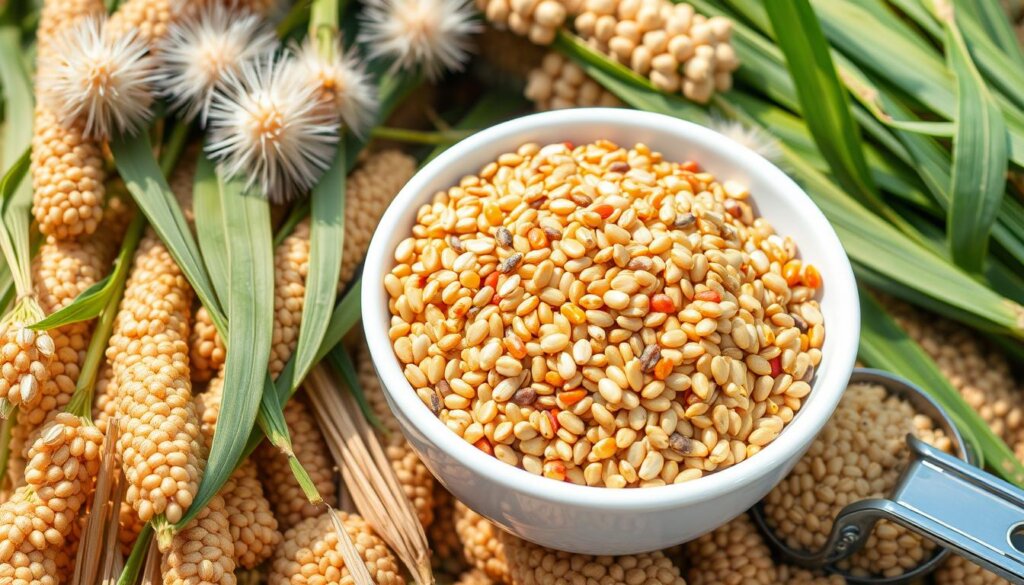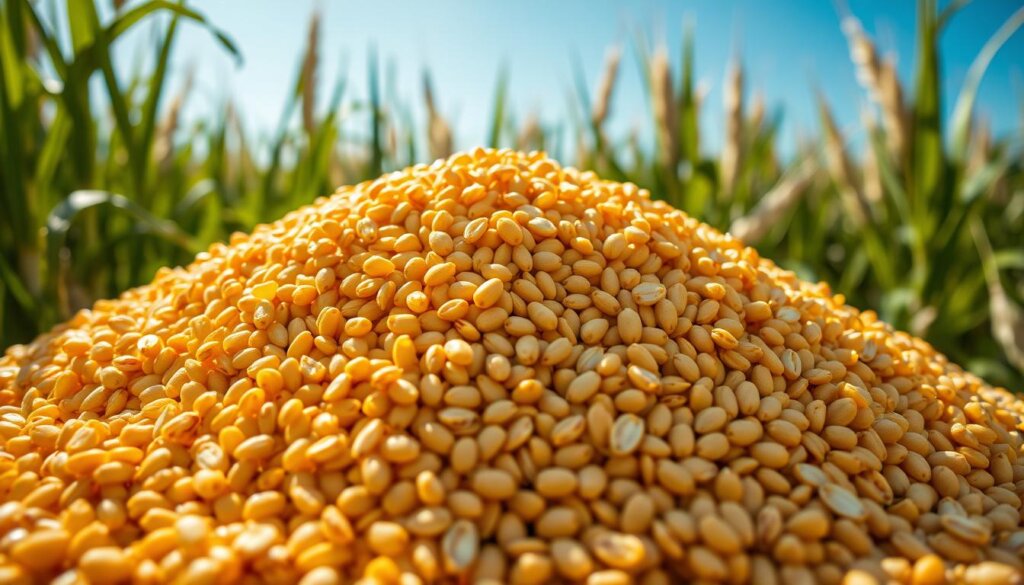Have you ever thought about a grain that’s as good as traditional ones but is gluten-free? Sorghum is a fantastic choice, especially for people with celiac disease or anyone looking for healthy, gluten-free food options.
As the fifth most grown cereal worldwide, sorghum plays a vital role in regions like Africa and South Asia, where drought is common. It’s also incredibly nutritious, packed with vitamins, minerals, and fiber, making it a powerhouse for your diet.
Curious about sorghum’s benefits and how it can transform your meals? Learn more about other gluten-free grains like Quinoa, Rice, and Millet. Discover how these grains can enhance your recipes while keeping your meals healthy and gluten-free.
Table of contents
What is Sorghum?
Sorghum is a cereal grain from Africa, now grown in many places, like the U.S. It’s a key crop worldwide, used in many ways. It’s good for you and can be cooked in different ways.
Understanding Sorghum as a Cereal Grain
Sorghum is great for cooking because it’s gluten-free. It comes in many colors, like white, yellow, and purple. It’s full of fiber, which is good for you.
You can cook it whole, make flour from it, or pop it. This makes it perfect for people who don’t eat meat or gluten.
Global Significance of Sorghum
Sorghum is very important globally. It’s the fifth most important cereal crop. It helps feed people in dry areas, like Africa and South Asia.
It’s a main food source in these places. Its ability to grow well in dry conditions makes it key in fighting hunger and malnutrition.
Different Types of Sorghum
There are many types of sorghum, each with its own uses. The main types are:
- White Sorghum: Good for baking and cooking because it tastes neutral.
- Waxy White Sorghum: Great for cooking.
- Black Sorghum: Has lots of antioxidants and tastes earthy.
- Burgundy Sorghum: Nutritious and has a unique color.
- Waxy Burgundy Sorghum: Like burgundy but with special starch.
- Sumac Sorghum: Known for its health benefits.
Sorghum can be made into many products, like flour and popped sorghum. This lets people use it in many ways in their cooking.

| Type of Sorghum | Color | Key Uses | Health Benefits |
|---|---|---|---|
| White Sorghum | White | Baking, Cooking | High in dietary fiber |
| Black Sorghum | Black | Cereal, Flour | Rich in antioxidants |
| Burgundy Sorghum | Burgundy | Cooking, Baking | High in essential nutrients |
| Sumac Sorghum | Dark Red | Syrup Production | Potential health benefits |
| Waxy White Sorghum | White | Baking, Cooking | Enhanced texture in baked goods |
Is Sorghum Gluten-Free?
Sorghum is a top choice for those avoiding gluten. It’s great for people with gluten intolerance or celiac disease. It’s packed with protein and fiber, making it a good pick for a gluten-free diet.
Explanation of Gluten-Free Grains
Gluten-free grains are key for those who can’t have gluten. Sorghum is naturally gluten-free, with lots of protein and fiber. It’s a safe and healthy option.
Adding different gluten-free grains to your diet is important. It helps you get all the nutrients you need.
Contamination Risks and Gluten-Free Labels
Even though sorghum is gluten-free, it can get contaminated. This happens during farming and processing. It’s best to buy products with gluten-free labels.
These labels mean the product meets gluten-free standards. They help you make sure your food is safe and meets your health needs.
| Grain Type | Protein (g) | Fiber (g) | Gluten-Free |
|---|---|---|---|
| Sorghum | 20 | 12 | Yes |
| Quinoa | 8 | 5 | Yes |
| Buckwheat Groats | 6 | 5 | Yes |
| Brown Rice | 6 | 3 | Yes |
| Amaranth | 9 | 5 | Yes |
Health Benefits of Sorghum
Sorghum is a super nutritious grain that offers many health benefits. It’s packed with nutrients that support a healthy diet. Knowing about sorghum nutrients shows its value in a balanced meal.
Nutritional Profile of Sorghum
A half-cup of cooked sorghum has about 316 calories. It also has 10 grams of protein, 3.3 grams of fat, and 69 grams of carbs. This grain is great for those who want more protein and less fat.
It has over 7 grams of dietary fiber. This helps with digestion and keeps things regular.
Vitamins, Minerals, and Antioxidants
Sorghum is full of vitamins and minerals. It has iron, magnesium, potassium, and B vitamins. These help with energy and metabolism.
It’s also full of antioxidants like flavonoids and phenolic acids. These fight off stress and inflammation. This makes sorghum a great choice for your meals.
Dietary Fiber and Digestive Health
The fiber content in sorghum is key for good digestion. It makes you feel full, helping with weight control. Eating sorghum can also help prevent constipation.
Its fiber is good for more than digestion. It can also lower cholesterol and control blood sugar. This makes sorghum a smart choice for a healthy diet.

Incorporating Sorghum into Your Gluten-Free Diet
Cooking sorghum opens up a world of meal preparation possibilities. It has a nutty flavor and robust texture. Sorghum adds a satisfying element to various meal ideas.
Cooking Techniques for Sorghum
Cooking sorghum is straightforward. Start by rinsing the grains under cold water. For best results, mix one cup of sorghum with three cups of water or broth.
Bring this mixture to a boil, then lower the heat. Let it simmer for about 50-60 minutes. This makes the grains tender and fluffy.
Versatile Uses in Dishes
Sorghum fits well into many recipes. Its mild flavor works great in:
- Salads and grain bowls, adding a nutritious base
- Pilafs and risottos for a hearty side dish
- Soups and stews, boosting flavor and nutrition
- Breakfast porridge, for a warm start
- Gluten-free granola bars, perfect for snacking
Sorghum is rich in nutrients. It has 10 grams of protein and 6 grams of dietary fiber per half-cup. Adding sorghum recipes to your diet can boost your health. Try new meal ideas and enjoy making delicious, gluten-free meals with this ancient grain.

Sorghum in Gluten-Free Baking
Sorghum flour is key in gluten-free baking. It adds unique flavors and textures. By following best practices and using the right flour mix, you can make tasty gluten-free bread and baked goods. Try out sorghum baking recipes to discover its full range.
Best Practices with Sorghum Flour
Here are some tips for using sorghum flour:
- Balance Flours: Mix sorghum flour with other gluten-free flours for the best taste and texture. White rice flour or buckwheat flour works well.
- Add Binding Agents: Use xanthan gum or psyllium husk powder to make your gluten-free bread elastic, like gluten.
- Experiment with Ratios: Changing the ratio of sorghum flour to other flours can change your baked goods’ texture. Try different ratios to find what you like.
Combining Sorghum with Other Gluten-Free Flours
Mixing sorghum flour with other flours can lead to amazing results. Sorghum flour, rice flour, and tapioca flour make great combinations:
- Sorghum flour adds a mild, sweet taste.
- Rice flour makes your baked goods light and fluffy.
- Tapioca flour adds chewiness, improving the texture.
These mixes let you try different sorghum baking recipes. You can make everything from hearty muffins to light cakes. Remember to use the right flour amounts for the best results. For gluten-free sourdough bread, check out this recipe.
Where to Find and Buy Sorghum
Sorghum products are getting more popular, thanks to their gluten-free nature. You can find whole grains, flour, syrup, and even popped snacks. These items are often found in health food sections or stores that focus on gluten-free products.
Available Types of Sorghum Products
In your grocery shopping, you might find these sorghum items:
- Whole Grain Sorghum
- Sorghum Flour
- Sorghum Syrup
- Popped Sorghum Snacks
These sorghum products are good for you. They have lots of protein and fiber. They also have important minerals and vitamins like calcium and iron. Plus, they are low in bad fats.
Recommendations for Online and Local Purchases
Buying sorghum online? Look for trusted brands like Bob’s Red Mill and Arrowhead Mills. Online stores like Amazon have many options. Prices vary, from $9.99 for 1 lb to $121.42 for 20 lbs.
| Package Size | Price | Availability |
|---|---|---|
| 1 lb | $9.99 | Available |
| 1.5 lbs | $15.99 | Available |
| 3 lbs | $22.99 | Only 7 left in stock |
| 6 lbs | $38.47 | Available |
| 10 lbs | $63.58 | Only 5 left in stock |
| 20 lbs | $121.42 | Available |
For easy shopping, check online for sorghum with good nutrition. Look for low glycemic index and anti-inflammatory benefits. Always check reviews and make sure it’s gluten-free.
Conclusion
Sorghum is more than just a gluten-free grain. It’s also very nutritious. It can make your meals better and more fun.
It’s safe for people with celiac disease. Sorghum doesn’t have harmful peptides found in wheat and barley. This makes it a great choice for gluten-free diets.
Adding sorghum to your meals can make your diet more interesting. It’s good for your health and tastes great. Try using it in gluten-free tortillas, bread, and snacks.
More people are looking for gluten-free options. Using sorghum can make your gluten-free life more exciting. It’s healthy and tasty, so give it a try!
FAQ
Is sorghum gluten-free?
Yes, sorghum is naturally gluten-free. It’s great for people with celiac disease or gluten intolerance. You can enjoy it without losing flavor.
What are the nutritional benefits of sorghum?
Sorghum is packed with nutrients. It has about 11 grams of protein and 7 grams of fiber per half cup. It also has vitamins and minerals like magnesium and iron.
Plus, it has antioxidants that fight oxidative stress.
How can I incorporate sorghum into my gluten-free diet?
Cook whole sorghum grains as a side dish. Use sorghum flour for gluten-free baking. Or add popped sorghum to snacks.
Its mild, nutty flavor works well in many recipes, from salads to breakfast porridge.
What cooking methods are best for sorghum?
You can cook sorghum whole, mill it into flour, or pop it like popcorn. To cook whole grains, rinse one cup of sorghum with three cups of water or broth.
Then, bring it to a boil and simmer until it’s tender.
Are there different types of sorghum?
Yes, there are several types. Grain sorghum is used for animal feed and food. Sweet sorghum is harvested for syrup.
There are also varieties like Onyx sorghum, bred for their antioxidants.
Can sorghum be contaminated with gluten?
Sorghum itself is gluten-free. But it can get contaminated with gluten during farming or processing. Always choose gluten-free products to avoid contamination.
Where can I buy sorghum products?
You can find sorghum products in health food stores, supermarkets, and online. Brands like Bob’s Red Mill and Arrowhead Mills have a range of sorghum products.
How does sorghum compare to other gluten-free grains?
Sorghum is special because of its high nutritional value and fiber. It’s versatile in cooking and baking. It tastes like rice and quinoa but offers unique health benefits.





